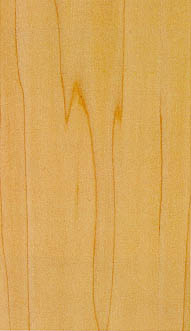Yellow Poplar (Liriodendron tulipifera)
 Description: The sapwood is creamy white and may be streaked, with the heartwood varying from pale, yellowish brown to olive green. The green color in the heartwood will tend to darken on exposure to light and turn brown. The wood has a medium to fine texture and is straight-grained; it has a comparatively uniform texture.
Description: The sapwood is creamy white and may be streaked, with the heartwood varying from pale, yellowish brown to olive green. The green color in the heartwood will tend to darken on exposure to light and turn brown. The wood has a medium to fine texture and is straight-grained; it has a comparatively uniform texture.
Main Uses: Light construction, furniture, kitchen cabinets, doors, musical instruments, exterior trim and siding, paneling, mouldings and millwork, edge-glued panels, turnings and carvings.
Physical Properties: A medium density wood with low bending, shock resistance, stiffness and compression values, with a medium steam-bending classification. Excellent strength and stability.
Availability: Very widely available.
Working Properties: A versatile wood that is easy to machine, plane, turn, glue and bore. It dries easily with minimal movement in performance and has little tendency to split when nailed. It takes and holds paint, enamel and stain exceptionally well.
| Machining | Nailing | Screwing | Gluing | Finishing |
| Excellent | Poor | Good | Good | Excellent |
Strength and Mechanical Properties: (inch-pound)
| Moisture Content | Green-12% |
| Specific Gravity | 0.40-0.42 |
| Static Bending: Modulus of Rupture (lbf/in^2) | 6,000-10,100 |
| Static Bending: Modulus of Elasticity (10^6 lbf/in^2) | 1.22-1.58 |
| Static Bending: Work to Maximum Load (in-lbf/in^3) | 7.5-8.8 |
| Impact Bending to Grain (in) | 24-26 |
| Compression Parallel to Grain (lbf/in^2) | 2,660-5,540 |
| Compression Perpendicular to Grain (lbf/in^2) | 270-500 |
| Shear Parallel to Grain (lbf/in^2) | 790-1,190 |
| Tension Perpendicular to Grain (lbf/in^2) | 510-540 |
| Side Hardness (lbf) | 440-540 |
Source: American Hardwood Information Center, Species Guide